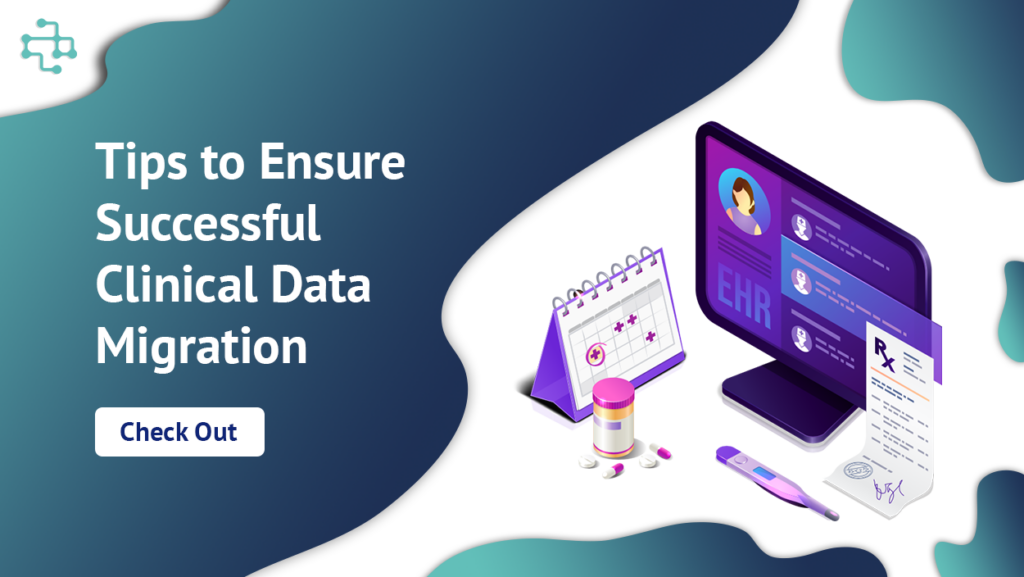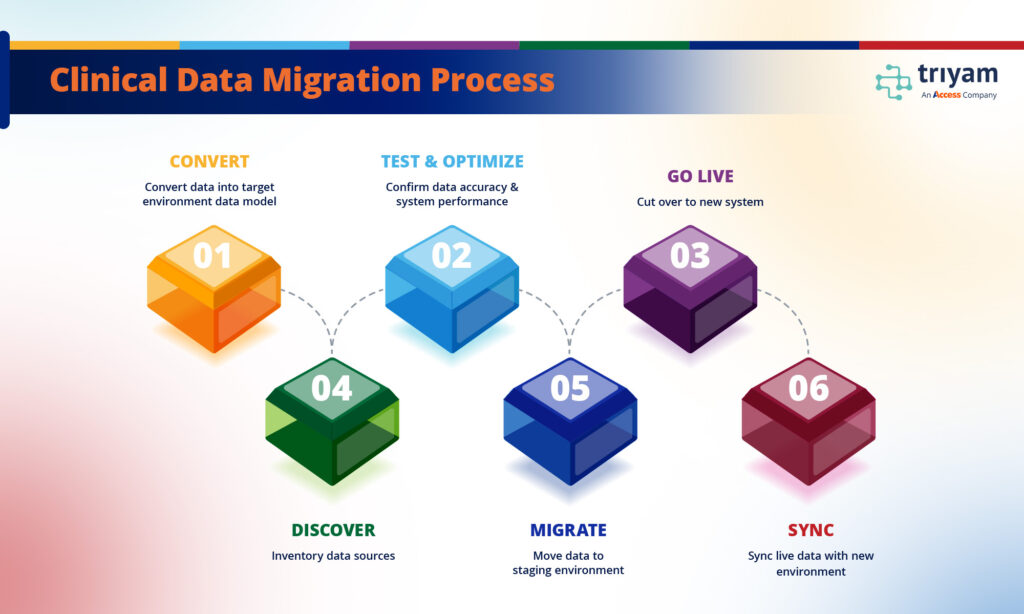
As policies evolve, technology develops, and health networks merge, medical institutions must contend with the problem of switching to a new electronic health record (EHR) system more frequently. Data migration is a challenge that frequently appears throughout this move. To clarify, data migration is the process of moving EHR data from one EHR to another. This crucial stage establishes the new EHR environment’s clinical data content, which may ultimately have an impact on clinical and institutional outcomes. The ideal method for defining institutional data migration based on the specific requirements of clinical end users currently lacks clear information.
Due to resource limitations, the amount of clinical data that may be moved might be restricted. For instance, it’s possible a new EHR system won’t accept data transferred from a proprietary EHR in a format that is compatible with it. Conversions to guarantee comprehensive data accessibility in a new EHR system can be difficult, expensive, and time-consuming. The effectiveness and efficiency of scripted data transfer has been demonstrated, but it is reliant on system compatibility, correct master patient lists, and the capability to precisely assign the proper codes to the clinical data being moved.
A legacy archive system is then used to store and provide access to non-migrated data. The integrity of the data and the clinical utility of the new environment are at risk if the scope of clinical data for an EHR migration is not carefully defined. Vendors may try to portray the procedure as requiring “only a few extra clicks,” but physicians may end up spending more time visiting the legacy archive to retrieve data, which could lead to fatigue and frustration. Medical waste in the form of redundant testing, and worse patient safety, may result if doctors choose to forgo clinical archival data retrieval in favor of repeating tests.
What Is Clinical Data Migration in Healthcare?
Clinical Data migration in healthcare entails moving data between systems or storage environments. Typical scenarios include:
- Shifting from on-premises to cloud-based platforms
- Changing vendors by transferring data to a new warehouse
- Upgrading to a more advanced Electronic Health Records (EHR) system
- Unifying patient records from multiple platforms into a single, centralized system
Here are some clinical data migration tips to ensure data integrity, minimize expenses, and hit targeted deadlines.
1. Join Forces With a Company That Specializes In Clinical Data Migration
Working with a vendor who only specializes in EHR data transfer and extractions, while also familiar with the subtleties of clinical code sets, is essential to the project’s success. A vendor of an EMR might not be as knowledgeable with the source EMR as they are with their own database structure. If the source EMR vendor needs to be contacted, this can be troublesome because it puts the healthcare organization in the middle of the suppliers. Choosing a vendor-neutral service provider with experience with both EMR systems can lower risk and boost project effectiveness. Make sure to call the service provider’s references to confirm that they successfully completed similar migration projects within the specified budget and time frame.
2. Create A Multidisciplinary Data Governance Team
While the IT department is responsible for the technical components of clinical migration, business stakeholders are primarily responsible for data scoping, validation, and quality assurance. Establish a cross-functional team of IT analysts and software users to provide input on the strategy for moving electronic medical data. To address inquiries regarding the data you have and don’t have, as well as the distinction between data that is extremely important and less important, make sure the appropriate HIM resources are there. Establish the procedures for testing, assessing, and approving data. Choose a project manager to get things started and a sponsor to give the final approval.
3. Specify The Amount Of EMR Data That Will Be Moved
The project becomes more difficult (and consequently more expensive) as you move more clinical data. Controlling expenses requires choosing which legacy EMR data to move and which to archive. Find out from your data governance team what information needs to be presented at the point of care, and how far back in time. The remaining historical data, including financial transaction history, can be secured as separate and searchable data elements in a long-term, HIPAA-compliant EMR archive once this clinical summary data set has been established. Although the destination EMR will probably take demographics, it might have restrictions on the kind or volume of clinical data that can be submitted.
4. Determine The Location In The Destination EMR Where The Source EMR’s Data Will Live
The location and format of the source data to be displayed in the target EMR is not always shown in a real demonstration or on-screen mock-up by third-party providers. So that expectations — and ultimately deadlines and prices — are satisfied, it is crucial to fully comprehend the final outcome data placements and workflows. If it isn’t perfect the first time, more time and effort will be required the next two or even three times. Negotiate data mapping and visualization into the contract as a deliverable because it is time-consuming and necessary.
5. The Data Mapping Should Be Documented For Future Use
The logic and database structure of the source EMR are almost certainly very dissimilar to those of the destination EMR. To eliminate errors and minimize redundancy, the two sources must be mapped if one system calls source ID “SID” and the other system calls source ID “SourceID.” Although formal documentation of data mapping should always be provided by a vendor as a delivery, this is not always the case. Each record is traceable by recording the data mapping attempts as the project develops. This means that as logical flaws or quality problems arise, they may be quickly fixed. Consider your data mapping documentation as a simple and quick way to find the relevant source EMR field. A lot of time and effort can be saved by formally documenting the data mapping.
6. Establish The Context In Which The Migration Of The Clinical Data Will Take Place
Will the relocation be on-site or off-site? It is crucial to consider the tools, materials, and infrastructure needed for both. If it will take place on-site: When will it be finished? How could the network be burdened or harmed while the data is transferred? To limit the throughput so that your users’ access to the network is not severely hindered, some math may be required. When it happens off-site: How will the vendor access the information? What steps are involved? How will security and privacy be handled?
Key Factors in Clinical Data Migration
Healthcare data migration presents distinct challenges due to the sensitive and regulated nature of the data. These include:
- Data Volume and Complexity: Healthcare organizations handle vast amounts of data in diverse formats. Migrating this data without downtime or loss is a significant hurdle.
- Legacy System Challenges: Outdated, siloed systems often lack compatibility with modern platforms, requiring extensive data transformation and manual effort.
- Data Quality Issues: Inaccurate, incomplete, or duplicate data in the source system can hinder migration and affect the new system’s performance.
- Security and Compliance Needs: Adhering to regulations like HIPAA or GDPR demands robust data encryption, access controls, and detailed audit trails.
- Minimizing Downtime: In settings where constant access to patient records is critical, even short disruptions can affect care, necessitating careful planning and efficient migration tools.
- System Compatibility and Integration: Variations in database structures, formats, and platforms between old and new systems pose technical challenges.
- Cost and Resource Allocation: Migration demands significant resources and budget, requiring a balance between costs and benefits, particularly for large-scale projects.
- Data Synchronization: Maintaining consistency between old and new systems during migration is crucial to avoid data loss or inconsistencies.
- Post-Migration Performance: The new system must ensure fast, reliable access to patient records for optimal functionality after migration.
- Staff Training and Change Management: Transitioning to a new system requires retraining staff and addressing resistance to change to ensure smooth adoption.
In conclusion, most healthcare organizations do not have the time or ability to conduct clinical data migrations exclusively on their own and most EMR vendors overestimate their ability to migrate legacy clinical data. Contact us to learn more about clinical data migration.


